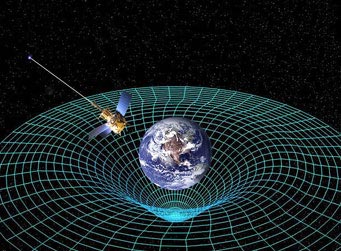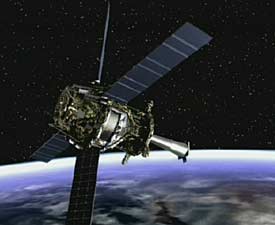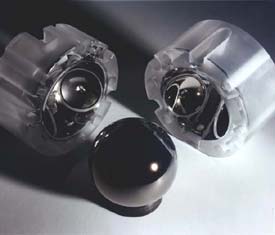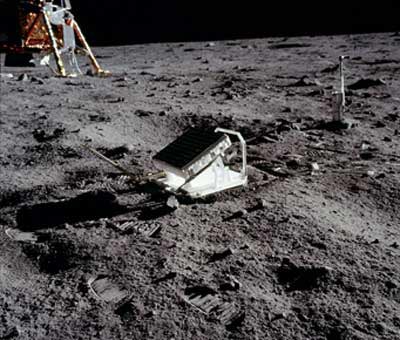You may have read Wednesday's news: Albert Einstein, Time magazine’s “Man of the Twentieth Century,” indeed did not goof up when he put forth the theory of general relativity.

Artist’s concept of the geodetic effect — Earth producing a dent in the spacetime fabric due to its gravity. (To understand such illustrations click here.)
NASA
NASA’s $750 million satellite Gravity Probe B proved that time and space do curve near massive objects like Earth, and also that space and time are dragged along a tiny trace by Earth’s rotation.
But wait a minute! Didn’t we already know this? To high precision?
The truth is, we did. The LAGEOS satellites, lunar ranging, the Cassini mission’s radio experiment, and binary pulsars, to name just a few, have all verified general relativity — including these two particular predictions — sometimes to much higher accuracy than Gravity Probe B (Sky & Telescope, July 2005 issue, page 33).
At least Gravity Probe B will go down in history for being the only experiment to prove Einstein right in one particular way so close his home planet.

Over the course of the mission, Gravity Probe B measured the warp of space from the geodetic effect as causing 6,601.8 plus or minus 18.3 milliarcseconds of drift in the gyroscropes' spin direction, and only 37.2 plus or minus 7.2 milliarcseconds due to the frame-dragging effect.
GP-B was the child of five decades of lobbying, planning, and execution. It was conceived in 1959 and launched in 2004 to test two predictions of general relativity. The first, the “geodetic effect,” describes the dent that Earth causes in the fabric of spacetime because of its mass. For a two-dimensional analogy, think of a bowling ball sitting on a trampoline.
The second is “frame-dragging,” which Joseph Lense and Hans Thirring proposed in 1918 using Einstein’s theory. This is the amount by which Earth twists spacetime as it spins on its axis. “Imagine the Earth as if it were immersed in honey,” says Francis Everitt, GP-B’s principal investigator at Stanford University. “As the planet rotates, the honey around it would swirl, and it’s the same with space and time.”
Frame dragging results from a general-relativistic effect called gravitomagnetism — so named because it’s analogous to the way magnetism was revealed to be merely the special-relativity transformation of an electrostatic field that moves. So, just as a moving electron creates a magnetic field, a moving mass generates a gravitomagnetic field. The field exerts a sideways force, similar to the force a magnetic field exerts on a charged particle, on any mass moving though it, causing the object’s path to deflect.
This was heady stuff in 1959. But by the time of GP-B’s much-delayed launch, other confirmations of these effects were dissipating much of its rationale.
A Long-Sought Goal

The gyroscopes are spheres coated in niobium, selected for its unique property of electric stability. The rotating spheres produce a magnetic field whose direction remains steady for years if undisturbed.
Courtesy Don Harley.
The experiment’s basic design was born in 1920, when physicists J. A. Schouten and Arthur S. Eddington suggested the use of gyroscopes to test general relativity. In 1959 MIT physicist Donald Pugh suggested using a satellite, whose motion would be compensated for atmospheric drag, to provide a perfect, zero-g inertial reference frame in which to hold the gyroscopes.
Orbiting Earth in a special housing at a height of 400 miles, GP-B’s gyroscopes consist of four spheres the size of Ping-Pong balls coated with niobium. They were cited in the Guinness World Records as the most perfectly spherical objects ever made. The housing was set to maintain a perfect lock on a guide star (IM Pegasi). If Newtonian physics were all that applied, the gyroscopes would never change orientation and stay pointed at the star. If Einstein were right, the two effects would cause the gyroscopes to drift by a tiny angle, measured in arcseconds, over the course of the mission.
But GP-B’s confirmation of the geodetic effect to a precision of 0.3% (6,601.8 ± 18.3 milliarcseconds) is not exactly stunning. Astronomers had already done this to 0.002% accuracy, 150 times better, by measuring the time delay in radio signals from the Cassini spacecraft as they passed through the gravitational field of the Sun.
“I am pleased but not impressed by the geodetic-precession part of the result,” said Michael Kramer, a member of an international team studying binary pulsars and a contributor to S&T on the subject (August 2010 issue). “However, for the frame dragging [part], I still think it is a significant advance as it really shows a direct measurement of the effect on a spinning top, which is really quite nice.”
But GP-B confirmed frame-dragging to only 20% accuracy (37.2 ± 7.2 milliarcseconds). Kramer called this “a very nice stone in the big mosaic to understand gravity,” while explaining that experiments on binary pulsars are aiming to calculate frame-dragging more precisely than GP-B.

Retroreflectors left behind on the Moon by the Apollo projects between 1969 and 1972 enable the calculation of the frame-dragging effect to a precision of 0.15%, much higher than GP-B’s 20%
Shweta Krishnan
And here, lunar-ranging experiments are way ahead. The Apollo astronauts left retro-reflector mirrors on the Moon, and laser ranging from Earth can now track their positions to millimeters. At that level of precision, the Moon’s motion in orbit has confirmed gravitomagnetism, the source of frame-dragging, to 0.15%, or 130 times better than GP-B.
“I won’t say there is no value in testing physics in a novel way,” says Tom Murphy (University of California in San Diego), a member of the lunar-ranging project, “but any discrepancy would have been incredibly jarring.”
Other physicists have said that if GP-B produced any other result than it did, they would probably just assume that GP-B’s engineers had pushed their technology too far.
Costs and Benefits
So, was it worth $750 million?
NASA considered terminating the GP-B program several times during its protracted development. As recently as 2008, a panel of 15 scientists ranked GP-B last in a review of which space-science missions should receive funding. But a very perseverant team led by Everitt lobbied Congress hard to see the mission through to completion, bypassing normal channels.
Speaking at a NASA press conference on Wednesday, Rex Geveden, GP-B’s program manager at the time of its launch (now the president of Teledyne Brown Engineering), said “Gravity Probe B is about science, technology and a triumph of the human spirit in the end.” The press-conference panel also boasted of GP-B’s educational value. The lengthy mission served as a training ground for 100 doctoral students, 15 other graduate students, 350 undergraduates, and more than four dozen high-school students.
Those who have long been following the mission heard a note of defensiveness here. Every space mission involves students; rarely does NASA have to cast that far to help justify it.
Even so, one can’t help but wonder what Einstein might have said if he were here to see the results. We can only look back to 1919, when shortly after the solar eclipse that provided general relativity’s very first (though weak) confirmation, he was asked what he might have felt if his prediction had been wrong. “I would feel sorry for the dear Lord,” he said. “The theory is correct.”
 8
8
Comments
Frank R.
May 6, 2011 at 6:38 pm
I love general relativity. I love gravitomagnetism, also known as "frame dragging" or the "Lense-Thirring effect". Another way to think of this phenomenon is as a "built-in" Coriolis effect, and it's clearly a real phenomenon as many astronomical observations have gradually made clear. Beautiful physics experiments are always a delight to see, but this was simply far too expensive. There's no way that this was worth the better part of a billion dollars, and as Shweta Krishnan notes, there was clear embarrassment in the presentation. The fact that the mission was a "training ground" for a bunch of doctoral candidates is simply a measure of its waste, not its value as science. Is that a "triumph of the human spirit" as they called it? Or a make-work program? Of course, there is another side to this. That giant chunk of cash was spread out over several decades resolving one unanticipated problem after another. If anyone, anyone at all, had been able to estimate at the outset that this mission would cost so much, it would never have seen the light of day. I don't think this was intentional waste, or even mundane government-project aste, as much as "unfortunate" waste: a project that turned out to be far more difficult than anyone expected at every stage of the game. It's just a shame that those who said all along that this was a hideously difficult project were ignored. The bank is now closed.
You must be logged in to post a comment.
Peter Wilson
May 7, 2011 at 7:03 am
What about the $1.6 billion WFIRST telescope to study dark energy? In today's economy, astronomers need to be careful in seeking funding to confirm what is already known.
You must be logged in to post a comment.
Jon Seamans
May 10, 2011 at 12:09 am
As there is no doubt that other techniques used to measure frame dragging have done better than Gravity Probe B, I believe the Lunar Laser Ranging accuracy of <1% is debatable. An author and accomplished GR expert, Ιgnazio Ciufolini, stated the following in a 2008 presentation dedicated to John A. Wheeler:
"It is proven, using two different methods, that LLR measures framedragging, in the sense of geodetic precession, but NOT framedragging by spin, in the sense of Lense-Thirring effect."
The difference lies in the fact the the Earth-Moon system is a gyroscope in the Sun's gravitational field (nothing to do with the Sun's rotation. From another paper, Ignazio states:
"In other words, the earth-moon system is essentially a gyroscope in the field of the sun (no different in principle than the earth acting as a gyroscope or a quartz ball in the Gravity Probe B (GPB) experiment acting as a gyroscope) and its frame-dragging effect due to interaction with the sun has been measured, using lunar laser ranging, to an accuracy of 0.35(%) accuracy..."
I am not an expert in GR, but unless there are very recent LLR measurements of substantially higher accuracy (I presume high enough to see the affect of Earth's rotation), the best mass-spin-based gravitomagnetism measurements to date using satellites are +/- a few percent obtained from LAGEOS and GRACE. The next satellite that's expected to generate ~1% accuracy is LARES.
You must be logged in to post a comment.
Paul White
May 14, 2011 at 7:58 am
Whenever I hear Einstein praised, I remember Newton's statement that "If I have seen farther, it is because I stood on the shoulders of giants." So it was with Einstein. It's important for new generations to learn that Einstein was building on the work of others in regard to relativity (although he failed to credit them in his papers): Galileo, who first described the phenomenon; and Newton, Lorentz, and Poincare being principal. Looking at quantum theory, Einstein was preceded by Max Planck, who discovered the phenomenon. And several men came up with e=mc^2--which is, at heart, a form of Newton's F=MA--before Einstein, beginning with Nikolai Umov in 1875. Umov's formula for matter/energy equivalence, e=kmc^2, included a constant "k" with a value between zero and one, considering that the conversion might not be one hundred percent.
You must be logged in to post a comment.
Lorenzo Iorio
November 30, 2013 at 4:26 am
The ArXiv moderators, in their comment to this submission
http://arxiv.org/abs/0712.3934
by G. Forst, reported a case of scientific misconduct pertaining the outcome of the GP-B mission by Ignazio Ciufolini, author of the competing LAGEOS tests. They write: ''This submission has been removed because 'G.Forst' is a pseudonym of Ignazio Ciufolini, who repeatedly submits inappropriate articles under pseudonyms. This is in explicit violation of arXiv policies.''
You must be logged in to post a comment.
Lorenzo Iorio
December 20, 2013 at 3:17 pm
The ArXiv moderators tried to get clever with all of us, to say the least, by censoring their own previous comment mentioning Mr. Ciufolini by invoking alleged "changed ArXiv policies" (what? when? After 5 years and 4 months, respectively, that they kept their own comments there?) in a private communication to me. So, here are all the screenshots
https://www.facebook.com/GPBframedraggingArXivCiufolini
You must be logged in to post a comment.
Lorenzo Iorio
December 27, 2013 at 7:36 pm
A NEW case of scientific misconduct by Mr. Ciufolini as reported by ArXiv. Read the comment by moderators at
http://arxiv.org/abs/gr-qc/070...
It is: " This submission has been made by G. Felici, a pseudonym of Ignazio Ciufolini, who repeatedly submits inappropriate articles under pseudonyms, in violation of arXiv policies " PS. About the OTHER case, the CiuForst one at http://arxiv.org/abs/0712.3934, now ArXiv has reinstated the original comment explicitly exposing Mr. Ciufolini. Let's wait for the next episode...
You must be logged in to post a comment.
Esnuka
May 20, 2017 at 8:49 am
I believe there is no frame-dragging effect on mass! NASA error?
An interesting experiment!
Understanding Gravity Probe-B experiment without math
http://www.molwick.com/en/gravitation/082-gravity-probe-b.html
http://www.molwick.com/en/gravitation/r-lense-thirring-frame-dragging.jpg
You must be logged in to post a comment.
You must be logged in to post a comment.